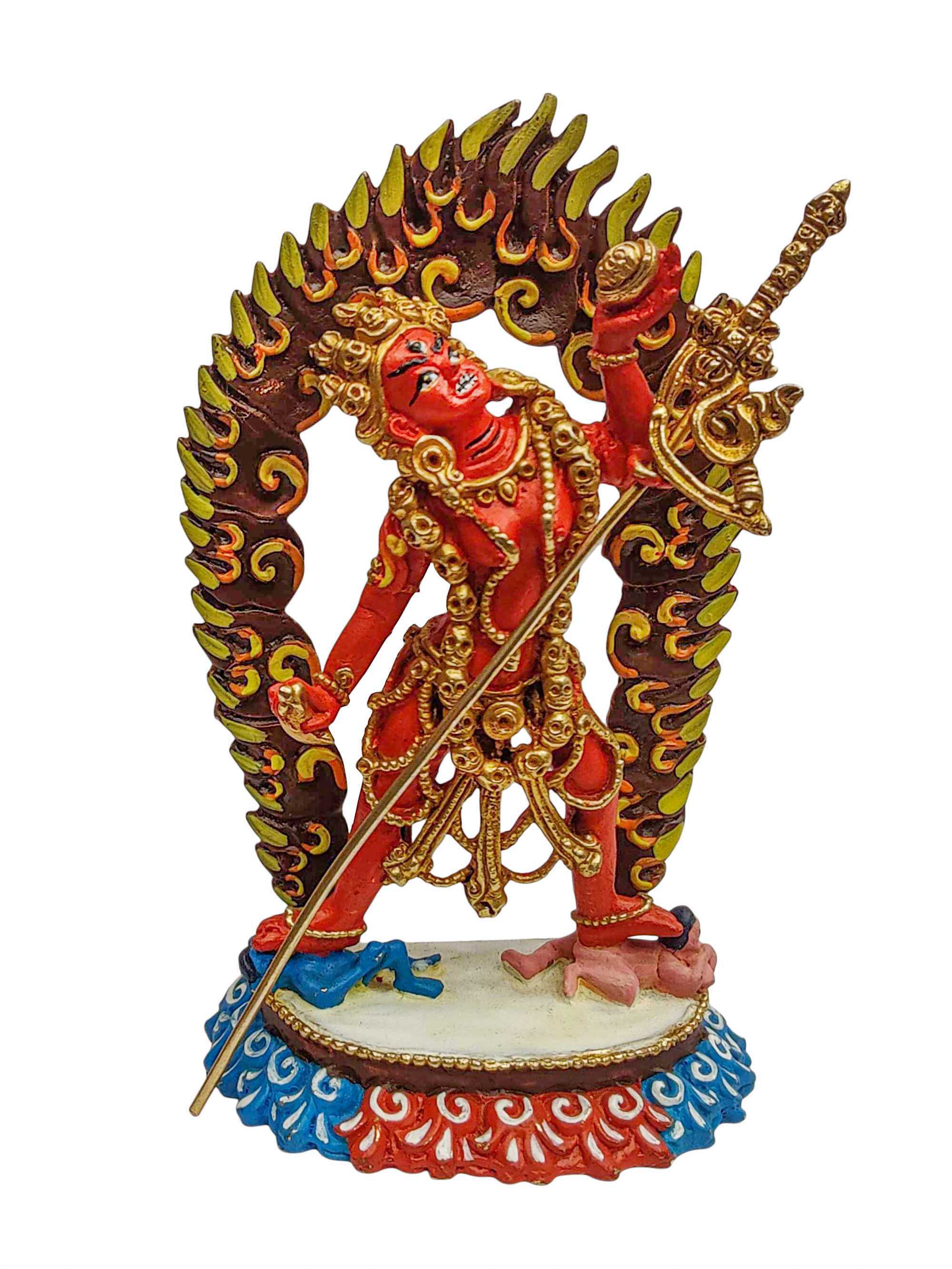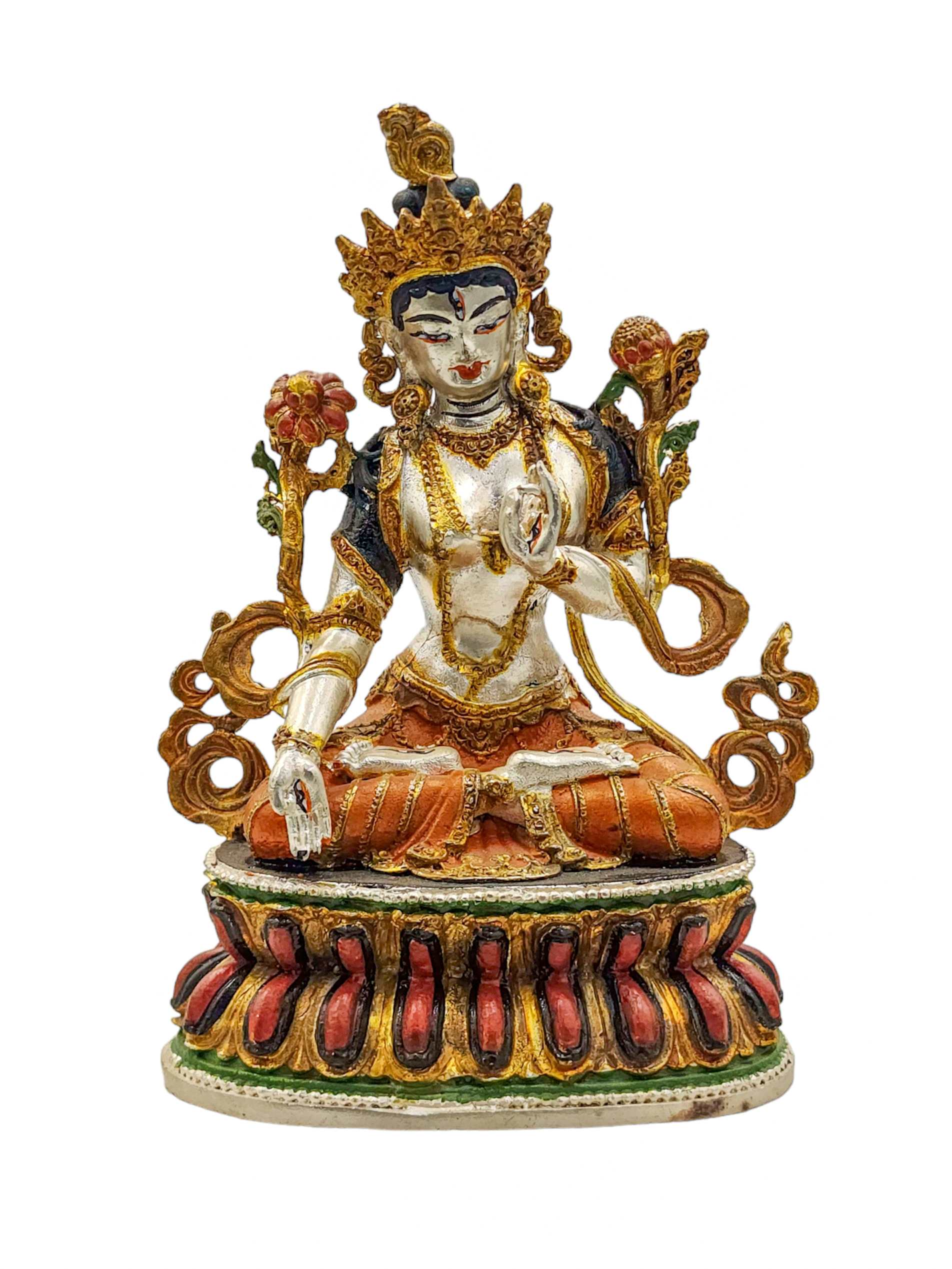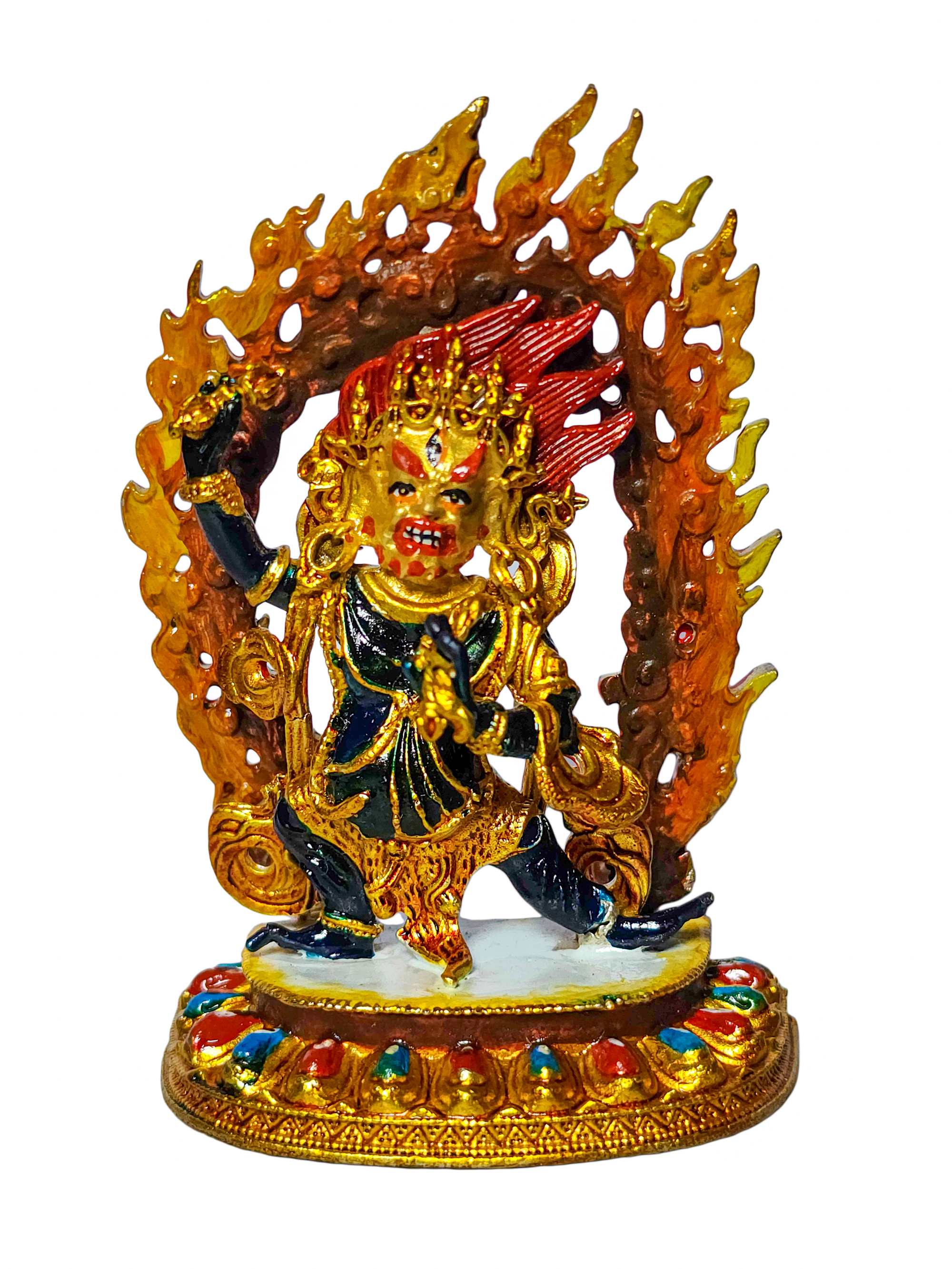Code
HCS25089
Weight
500 gm / 1.1 lbs
Size
13x9x7 Cm / 5.12 Inches
Material
Copper
Availability
Available

Safe Payment
We accept Paypal, Money Transfer, Bank Transfer
Confidence
Protection covers your purchase and personal data.
Worldwide Delivery
We ship Worldwide, except Russia.Shipping cost US$25.2 for upto 0.5 kgs

Hotline
Talk to help line for your question on 9841267335About Color Finishing
The Buddhist Statue Miniature Statue Of, Hevajra, [traditional Color] is adorned with traditional colors, creating a captivating aesthetic through a combination of gold and various hues. This painting technique follows a time-honored process that aims to faithfully represent the Buddhist Statue Miniature Statue Of, Hevajra, [traditional Color] in accordance with traditional color descriptions. In the context of Buddhist statues, this approach holds great significance. Each statue has its own primary color, and it is crucial to depict the statue in its authentic shade. Read More . . .
The Buddhist Statue Miniature Statue Of, Hevajra, [traditional Color] is adorned with traditional colors, creating a captivating aesthetic through a combination of gold and various hues. This painting technique follows a time-honored process that aims to faithfully represent the Buddhist Statue Miniature Statue Of, Hevajra, [traditional Color] in accordance with traditional color descriptions. In the context of Buddhist statues, this approach holds great significance. Each statue has its own primary color, and it is crucial to depict the statue in its authentic shade. Read More . . .
Ceramic Molding System
The Buddhist Statue Miniature Statue Of, Hevajra, [traditional Color] has been crafted using the Ceramic mold casting process, a modern approach that provides an alternative to traditional methods such as the lost-wax system or rubber molding. Also referred to as ceramic molding, this technique involves the creation of a ceramic mold to cast the statue. The process begins by making a precise and detailed wax model of the desired sculpture. The wax model is then coated with layers of ceramic material, creating a sturdy mold. Once the mold is complete, it is fired in a kiln, causing the wax to melt and escape, leaving behind a cavity that perfectly replicates the original sculpture. Molten metal is then poured into the mold, allowing it to fill the cavity and take on the desired form. Once cooled and solidified, the ceramic mold is carefully broken away, revealing the final metal statue. Read More . . .
The Buddhist Statue Miniature Statue Of, Hevajra, [traditional Color] has been crafted using the Ceramic mold casting process, a modern approach that provides an alternative to traditional methods such as the lost-wax system or rubber molding. Also referred to as ceramic molding, this technique involves the creation of a ceramic mold to cast the statue. The process begins by making a precise and detailed wax model of the desired sculpture. The wax model is then coated with layers of ceramic material, creating a sturdy mold. Once the mold is complete, it is fired in a kiln, causing the wax to melt and escape, leaving behind a cavity that perfectly replicates the original sculpture. Molten metal is then poured into the mold, allowing it to fill the cavity and take on the desired form. Once cooled and solidified, the ceramic mold is carefully broken away, revealing the final metal statue. Read More . . .
Brief Introduction :
Hevajra is one of the main yidams in Tantric, or Vajrayana Buddhism. Hevajra's consort is Nairātmyā
Iconography and different forms of Hayagriva :Kaya Hevajra
The two armed Body (Kaya) Hevajra described in the Hevajra Tantra stands in an advancing posture on a multi-coloured lotus, corpse, and sun disk. He is dark blue in colour. His right hand holds a vajra club, and his left hand holds a vajra-marked skull cup. He embraces his consort Vajranairatma . A khatvanga staff rests on his left shoulder and he is adorned with the six symbolic ornaments.
In the Sadhanamala this form of Hevajra is single (ekavira) - without a consort.
Vak Hevajra
The four armed Speech (Vak) Hevajra described in the Hevajra Tantra stands in an advancing posture on a multi-coloured lotus, corpse, and sun disk. He is dark blue in colour. One right hand holds a vajra and one left hand a skullfull of blood, the other pair of arms embrace his consort Vajravarahi .
Citta Hevajra
The six armed Mind (Citta) Hevajra described in the Hevajra Tantra stands in an advancing posture with right leg extended and left bent on a multi-coloured lotus, corpse, and sun disk. He is dark blue in colour with three faces - C. blue, R. white and L. red. Each face has three blood shot eyes and four bared fangs, and frowns with knotted brows. His tawny hair streams up surmounted with a crossed vajra.. Two right hands hold a vajra and a knife, two left a trident and a bell; the remaining pair of arms embrace his consort Vajrasrinkhala Hevajra is imbued with the nine dramatic sentiments and adorned with a diadem of five dry skulls, a necklace of fifty fresh heada and the six symbolic ornaments or 'seals'.
Hrdaya Hevajra
The sixteen-armed, four-legged eight-faced Heart (Hrdaya) Hevajra described in the Hevajra Tantra stands with two legs in ardha-paryanka and the other two in alidha posture (left bent, right extended) on a multi-coloured eight petalled lotus, the four Maras in the forms of yellow Brahma, black Vishnu, white Shiva (Mahesvara) and yellow Indra and a sun disc resting on their hearts.
Sri Hevajra
is 16 years old, black in color, naked, with eight faces, sixteen arms and four legs. His central face is black, the first right white, the first left red, the upper face smoke-coloured and ugly; the outer two faces on each side, black. All have three round blood shot eyes, four bared fangs, a vibrating tongue, and frowning with knotted brows. His lustrous tawny hair streams upward crowned with a crossed vajra. He is adorned with a diadem of five dry skulls. The sixteen hands hold sixteen skull cups. The central pair of arms skull contain a white elephant and the yellow earth-goddess Prithvi, and embrace his consort Vajranairatma (rDo-rje bDag-med-ma) whose two legs encircle his body. Her right hands holds a curved knife (kartika), while the left is wrapped around the neck of her lord and holds a skullcup (kapala). In the other seven skull cups held in Hevajra's outer right hands are: a blue horse, a white-nosed ass, a red ox, an ashen camel, a red human, a blue sarabha deer, and an owl or cat. In the skull cups in the outer seven left hands are the white water-god Varuna, the green wind-god Vayu, the red fire-god Agni / Tejas, the white moon god Candra, the red sun god Surya or Aditya, blue Yama lord of death and yellow Kubera or Dhanada lord of wealth. Hevajra is adorned with the six symbolic ornaments: circlet, earrings, necklace, bracelets, girdle armlets and anklets and smeared with the ashes of the charnel ground. He wears a necklace of fifty freshly severed human heads.
The two armed Body (Kaya) Hevajra described in the Hevajra Tantra stands in an advancing posture on a multi-coloured lotus, corpse, and sun disk. He is dark blue in colour. His right hand holds a vajra club, and his left hand holds a vajra-marked skull cup. He embraces his consort Vajranairatma . A khatvanga staff rests on his left shoulder and he is adorned with the six symbolic ornaments.
In the Sadhanamala this form of Hevajra is single (ekavira) - without a consort.
Vak Hevajra
The four armed Speech (Vak) Hevajra described in the Hevajra Tantra stands in an advancing posture on a multi-coloured lotus, corpse, and sun disk. He is dark blue in colour. One right hand holds a vajra and one left hand a skullfull of blood, the other pair of arms embrace his consort Vajravarahi .
Citta Hevajra
The six armed Mind (Citta) Hevajra described in the Hevajra Tantra stands in an advancing posture with right leg extended and left bent on a multi-coloured lotus, corpse, and sun disk. He is dark blue in colour with three faces - C. blue, R. white and L. red. Each face has three blood shot eyes and four bared fangs, and frowns with knotted brows. His tawny hair streams up surmounted with a crossed vajra.. Two right hands hold a vajra and a knife, two left a trident and a bell; the remaining pair of arms embrace his consort Vajrasrinkhala Hevajra is imbued with the nine dramatic sentiments and adorned with a diadem of five dry skulls, a necklace of fifty fresh heada and the six symbolic ornaments or 'seals'.
Hrdaya Hevajra
The sixteen-armed, four-legged eight-faced Heart (Hrdaya) Hevajra described in the Hevajra Tantra stands with two legs in ardha-paryanka and the other two in alidha posture (left bent, right extended) on a multi-coloured eight petalled lotus, the four Maras in the forms of yellow Brahma, black Vishnu, white Shiva (Mahesvara) and yellow Indra and a sun disc resting on their hearts.
Sri Hevajra
is 16 years old, black in color, naked, with eight faces, sixteen arms and four legs. His central face is black, the first right white, the first left red, the upper face smoke-coloured and ugly; the outer two faces on each side, black. All have three round blood shot eyes, four bared fangs, a vibrating tongue, and frowning with knotted brows. His lustrous tawny hair streams upward crowned with a crossed vajra. He is adorned with a diadem of five dry skulls. The sixteen hands hold sixteen skull cups. The central pair of arms skull contain a white elephant and the yellow earth-goddess Prithvi, and embrace his consort Vajranairatma (rDo-rje bDag-med-ma) whose two legs encircle his body. Her right hands holds a curved knife (kartika), while the left is wrapped around the neck of her lord and holds a skullcup (kapala). In the other seven skull cups held in Hevajra's outer right hands are: a blue horse, a white-nosed ass, a red ox, an ashen camel, a red human, a blue sarabha deer, and an owl or cat. In the skull cups in the outer seven left hands are the white water-god Varuna, the green wind-god Vayu, the red fire-god Agni / Tejas, the white moon god Candra, the red sun god Surya or Aditya, blue Yama lord of death and yellow Kubera or Dhanada lord of wealth. Hevajra is adorned with the six symbolic ornaments: circlet, earrings, necklace, bracelets, girdle armlets and anklets and smeared with the ashes of the charnel ground. He wears a necklace of fifty freshly severed human heads.


![Buddhist Statue Miniature Statue Of, Hevajra, [traditional Color]](https://handmadeexpo.com/pics/product/thumb/25089.jpg)
![Buddhist Statue Miniature Statue Of, Hevajra, [traditional Color]](https://www.handmadeexpo.com/pics/product/thumb/25089_0.jpg)
![Buddhist Statue Miniature Statue Of, Hevajra, [traditional Color]](https://www.handmadeexpo.com/pics/product/thumb/25089_1.jpg)
![Buddhist Statue Miniature Statue Of, Hevajra, [traditional Color]](https://www.handmadeexpo.com/pics/product/thumb/25089_2.jpg)

 High Quality,
High Quality,  High Quality,
High Quality,  of, Medicine Buddha,
of, Medicine Buddha,  of, Medicine Buddha,
of, Medicine Buddha,  with Consort,
with Consort,  with Consort,
with Consort,  Traditional Color Finishing" title="Vajrakilaya - Dorje Phurba Handmade Statue
Traditional Color Finishing" title="Vajrakilaya - Dorje Phurba Handmade Statue  Traditional Color Finishing" title="Vajrakilaya - Dorje Phurba Handmade Statue
Traditional Color Finishing" title="Vajrakilaya - Dorje Phurba Handmade Statue  High Quality,
High Quality,  High Quality,
High Quality,  High Quality,
High Quality,  High Quality,
High Quality,  White Tara, Buddhist Miniature Statue,
White Tara, Buddhist Miniature Statue,  White Tara, Buddhist Miniature Statue,
White Tara, Buddhist Miniature Statue,  Vajrasattva, Buddhist Miniature Statue,
Vajrasattva, Buddhist Miniature Statue,  Vajrasattva, Buddhist Miniature Statue,
Vajrasattva, Buddhist Miniature Statue, 
 Vajrapani, Buddhist Miniature Statue,
Vajrapani, Buddhist Miniature Statue,  Vajrapani, Buddhist Miniature Statue,
Vajrapani, Buddhist Miniature Statue,